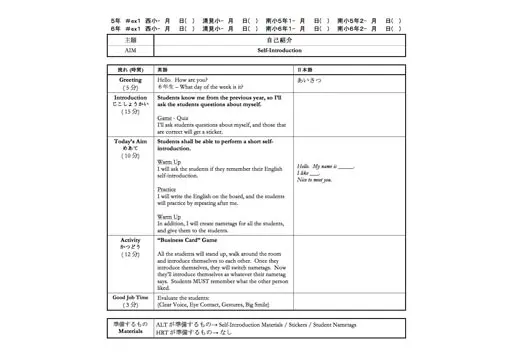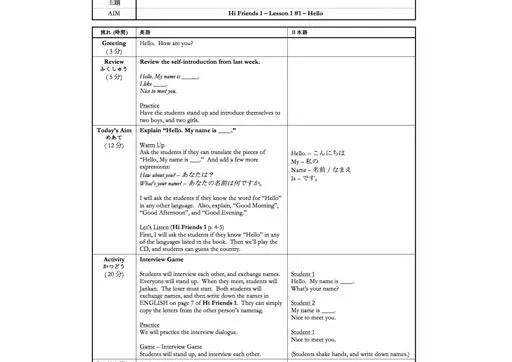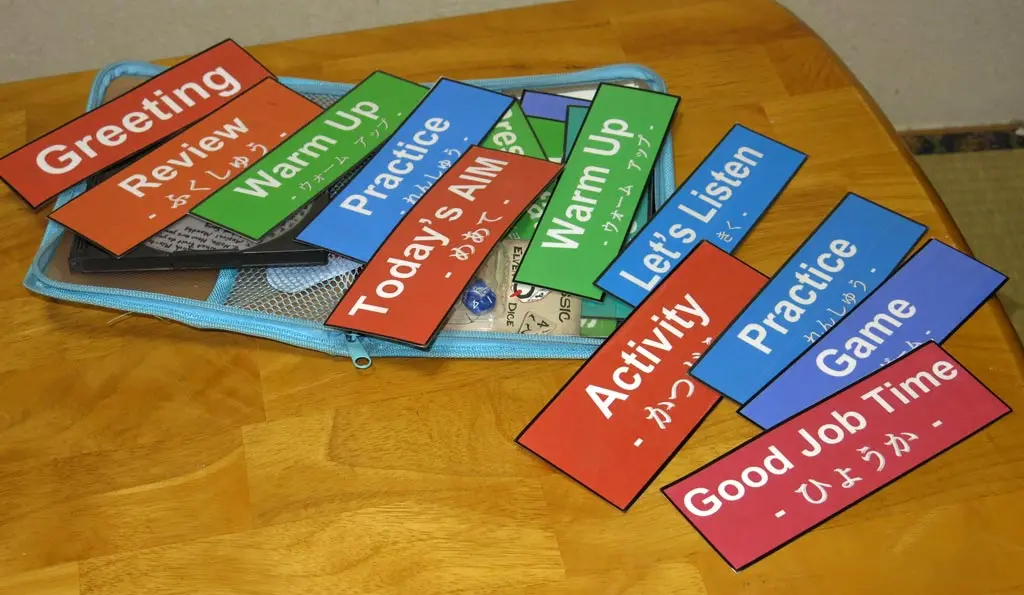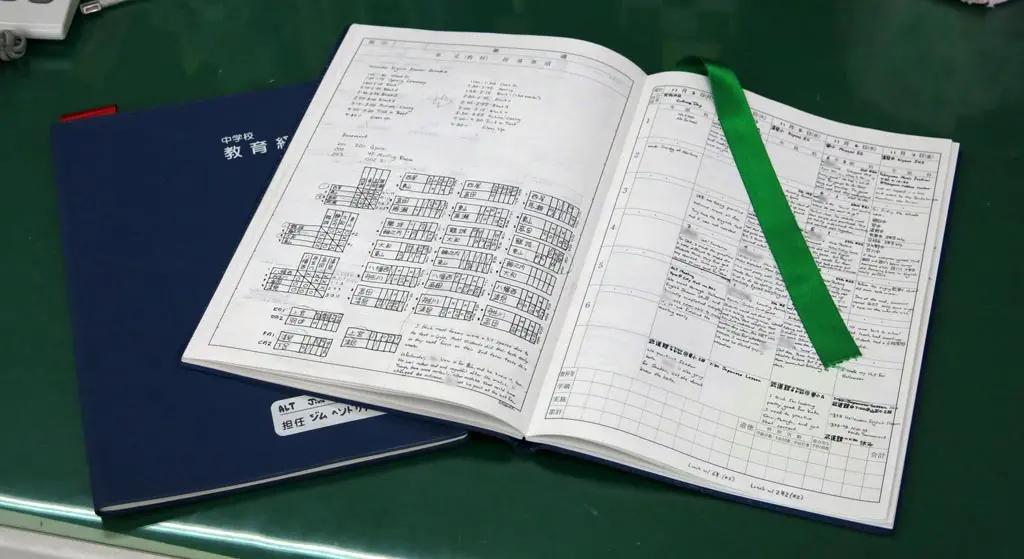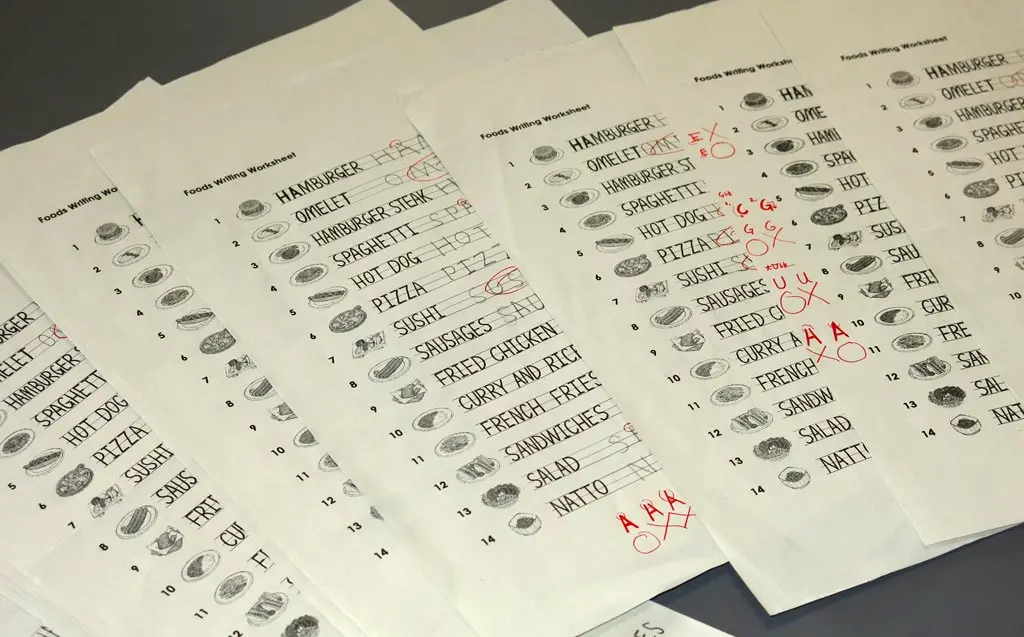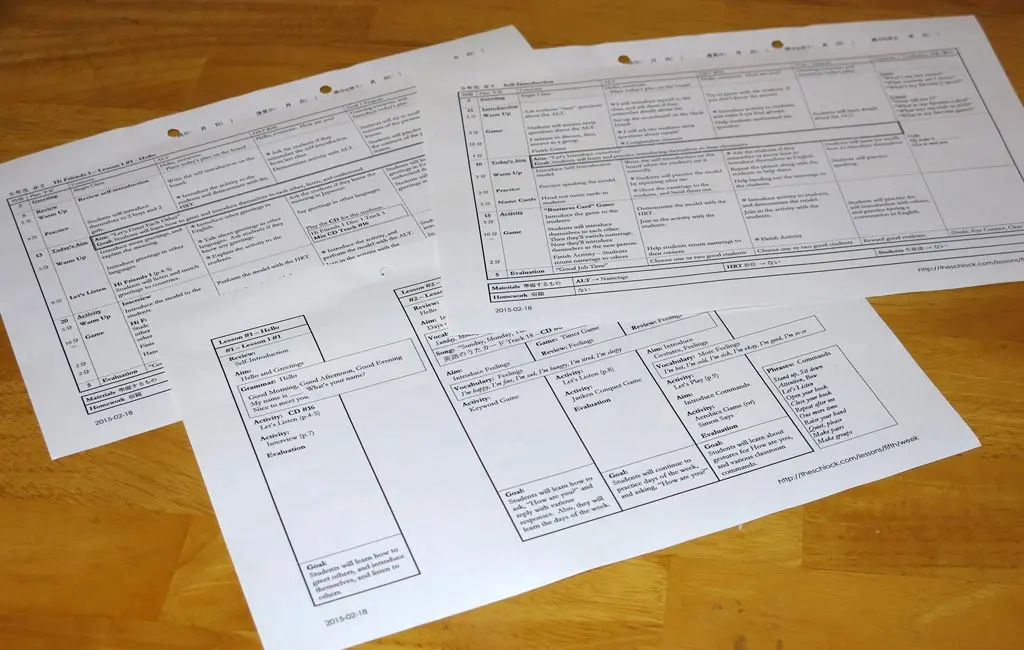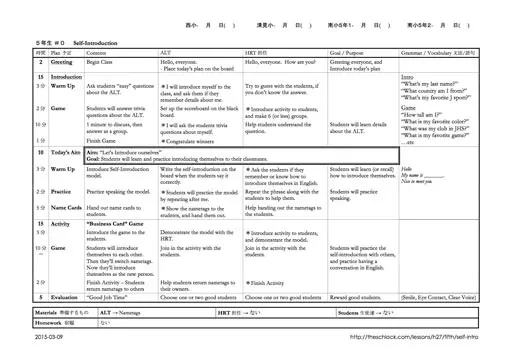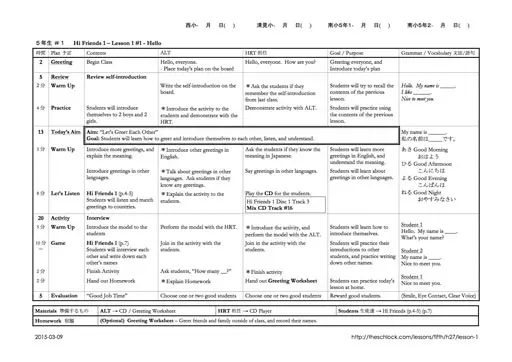Currently, I am an ALT teaching English in Takayama, Gifu, Japan. I teach at both junior high and elementary levels. My role in junior high is more of an assistant to the full-fledged English teachers at school. But my role in elementary schools is much more autonomous. I teach English with the home room teacher, HRT, and the HRTs are usually not English teachers. They tend to leave all the planning, preparation, and execution of the class to me, the ALT.
For planning and preparation, and for every class I've ever done, I've written a lesson plan. A lesson plan is exactly what it sounds like. It's a (somewhat) detailed account of everything I plan to do for the lesson, including how long things might take, and what materials are required. It's essentially a recipe.
In the next year, I plan on changing how I write my lesson plans, and how I conduct class. This post is the story of my past, present, and future of writing lesson plans. It's where I've been, where I am, and where I intend to do in the next year.
This is where I've been.
This is a collection of every lesson plan, and worksheet I've written over the last two years. Both fifth and sixth grade have one hour of English of each week. There are 43 weeks in a school year, but only 35 are required for English. I teach the other lower grades about once a month.
Here are two example lesson plans.
These are my first two classes for fifth grade 5年生 for the 2014 school year. The first class is my self-introduction. The second class begins the material from Hi Friends 1, the official text book for the course.
Almost all of my lesson plans follow the common "Engage -> Study -> Activate" pattern. I learned this from that online TEFL course I attended two years ago. The engage phase essentially warms up the students. It gets them thinking about the subject and recalling knowledge they already know. The study phase introduces new content to the students. The activate phase gives the students a chance to use this knowledge for themselves.
My self-introduction lesson doesn't follow this pattern exactly, but my plan for Lesson 1 does. For all my lesson plans, my review section is the engage phase. "Today's Aim" is the study phase. And "Activity" is the activate phase.
The review phase is essentially a tool box. I'm making a list of everything a student needs to continue the lesson, and putting those contents on the black board. Even if a student was absent, or totally forgot the previous class, everything they need to know to continue is presented to them at the top of class, and put into view.
Then, continuing the lesson, I add something new. A new tool for the tool box, if we continue this analogy. I give them the tool, explain it to them, teach them how to use it, and then we practice.
At the end of every lesson is the activity. The activity makes use of the new tool, and uses the other tools as well. This gives students a chance to use what they've learned for themselves, and understand it better.
In class, I'm very upfront about what we plan on doing.
At the top of class, I place cards on the black board detailing the outline of my lesson plan. Sometimes I go into detail upfront, but only if it's something irregular, or new.
Prior to every class, I meet with the home room teacher, give them a copy of the lesson plan, and discuss the contents. And I usually do this several days in advance. I rotate around to 3 separate elementary schools, and before I leave one elementary school for a day, I will meet with all the teachers for classes I have on my next visit. So when I'm done for the day, everything is set up for the next time I'm there.
During our meeting, I will make it clear if there's anything I need the home room teacher to do, or prepare in advance in order to make class go as smooth as possible. Also, we can iron out any problems that might occur with my plan, or address any problems specific students might have in class.
Explaining everything is great for both of us. I can hear myself talk and essentially practice explaining things the way I will in class. Hell, if I can't explain my games to the students, there's no way the students will understand. And if the students don't quite understand me, the teacher knows what is going on, and can make things clear for the students.
I should quickly mention where I actually come up with my ideas for lessons. The crux of every ALT is coming up with appropriate and effective games and activities for students to use what they've learned. ALTs use a variety of resources to come up with these ideas.
I rarely actually come up with a completely new original idea that really works in class. Sometimes it happens, but more often it's a variation of something else.
All of my best ideas have come from other ALTs and teachers. Other ideas have come from the recommended lesson plans, the Gifu published lesson plans, predecessor's lesson plans, Englipedia, and that Team Teaching Pizza book. I actually use the text book on occasion, too.
All the ideas that I use (or steal) are ones that I can visualize myself doing in class. If there's something amazing game out there, but I can't actually see how it fits into my teaching style or plans, then I'm not going to use it.
After writing my first few plans, it became VERY clear that I needed to plan further ahead than just the next week. I needed to organize all the goals for a lesson, and put them in a clear and logical order that makes sense. Otherwise, I was forgetting some parts of the lesson, or introducing them too late, or not fully understanding the point of the lesson.
I started writing a syllabus for the whole lesson and quickly wrote down the review, aim, and activities for each class. I should've added one here as an example, but it was basically just a straightforward, topdown list. This really helped me visualized the end, which helped make the journey more successful, and content rich.
I began giving these to my teachers whenever we began a new lesson in the book so they could see the end, too.
After every lesson, and every day at school, I record the results of my lesson plans in my schedule book.
I write about the good and the bad. I write about events that happen at school, and whether or not the students were more annoying than usual. I also write about events that happen on the weekend, like results of Kendo tournaments, or information from conferences. Usually things I don't write blog posts about.
I feels good to have a handwritten account of my daily life, even though most of this information is recorded elsewhere. It's all in one place in this book, and easy to reference.
It's really good for evaluation. It also proves to the other teachers how much you think about the quality of your lessons, and how you might improve them. Many teachers have done the whole すごい thing after taking a look.
Beyond that, it's a great keepsake for the future after I'm done here. I can look back and recall daily events I had forgotten. :)
As I've gotten more and more confident teaching in classrooms, and thinking more and more about what I can do for the students to learn better, I began introducing homework into my class.
The focus of teaching English in elementary school is communication. We are to get the students to talk, to learn some things, and to get super comfortable with the idea of the language before shoving it down their throats in junior high school. English in elementary school is not graded in any official manor. Teachers obviously make notes about the students, and talk to them about participation, but it doesn't really matter.
But with the focus on communication, listening and speaking, elementary education is missing out on half of what makes up a language: reading and writing. ALTs aren't supposed to teach it, blah blah blah, but it's still very important.
Well, I teach that to the students outside of class in the form of homework.
I give students these vocabulary sheets at the start of each lesson after I've introduced all the new words. Then at home, they can practice writing out the words. They can practice reading them, too. If they've completed the homework, then I reward them with a sticker. :)
Homework extends my reach as a teacher outside of class. Students can continue the lesson, and continue to learn and practice the contents. Also, my homework tends to list out of the contents of the lesson, so students have a clear account of what's expected of them. The text book does not do this at all.
This is what I've been doing for the past year and a half.
As the 平成26 school year comes to a close, for the first time, I have a full picture of an entire school year from start to finish. I can start thinking about how other lessons in the book relate to each other. And I can think about how I can further build that tool box throughout the entire year, rather than just a lesson at a time. And how I can write lessons that keep students coming back to their tool box.
But before that, there is a fundamental problem with my current lesson plans.
Elementary school English is meant to be team taught by the home room teacher and ALT. I've been running the show the entire time, and not giving the teacher a chance to teach, or even learn themselves. Usually they relegate themselves to the side or back of the room, and watch the class along with the students. They tend to keep the peace, and help out students, too, but it's a very secondary role in class.
This is bad because if and when I leave a school, I will leave a massive hole. New ALTs are completely inexperienced in almost all aspects of teaching. I was an absolutely wreck in the beginning. Current teachers won't necessarily know how to continue my lessons because I'm doing everything myself. New ALTs won't know what to do, either, and teachers will have a difficult time keeping class together at first.
My teaching style needs to teach the teachers, too. I need to give them confidence to teach English just as much as I do. I need to start focusing on team teaching, and for the next year I'm rewriting my lesson plans to do exactly that.
Here are my new lesson plans for 平成27, 2015.
These are the exact same lessons from earlier, but with the addition of 3 more columns.
There's an ALT column, and an HRT column. These two columns detail exactly what our responsibilities will be during class, and how we can work together. The * depicts the lead for each section.
There's also a goal and purpose column which was sorely missed from my previous plans. This is actually something required for writing lesson plans that I had never included before. For each part of the lesson, I'm essentially justifying why I'm doing it, and what I expect the students to get out of it.
This is a massive boon as it helps the HRT understand why I'm doing what I'm doing. Additionally, when writing the plan, it helps me think of more meaningful contents for the lesson, and allows me to get rid of useless, time wasting components.
Obviously flow is still important. Lessons can't all be meat. There still needs to be some fluff to give the meat more meaning. But this column simply states that everything is in here for a reason. No bullshit.
This is all personified in the middle of the document with the Aim. The Aim is a catch-phrase for the goal of the lesson, which is further detailed underneath. I plan on writing out the aim on the board for each lesson. Hopefully this will give more clarity to the students about what is going on in class.
I've also rewritten my syllabus. Now that I've been through an entire school year, and can look back, I tried to write something that shows the relationships between each lesson as they go forward.
Each column is a micro version of each lesson that includes the bullet points, and the contents I intend to teach. If those contents are used in the next lesson, I try to show that relationship. This is amazing for teachers to understand where things are going, and how to get there.
Also, they can see everything I plan on teaching for the entire year.
All of my lesson plans and materials are already hosted on this website, but now I'm making that more apparent by including a URL at the bottom of every plan. If teachers are missing an old plan, they can easily retrieve the file.
If some ALT in the future finds a single plan and wants to know more, they can do so. I've rewritten my entire ALT materials page to be more front facing, and easily to get at the actual files.
Take a look at theschlock.com/lessons!
Along with the plans and materials, I have a blog post attached writing out all of thoughts about why I did what I did, what went into making the materials, and how each class actually went. The good, the bad. The surprises, the boredom. And the results. Plenty of pictures, too. :)
Through writing plans in this way, and pointing them back to my website, hopefully I can more properly educate my incoming successor when I leave. Hopefully they can understand the flow of class, and how to manage it, and the amount of work needed to make their classes effective.
At the end of the 平成27 school year, I'll have an entire book created and ready to hand off.
As I've continued to get more confident giving out homework, there's really no reason I shouldn't do this more often. If we're doing an interview in class, I think it's a great idea to give the students an extra sheet, and have them interview their parents, other family members, or teachers. Using their newly learned language outside of class should really be the goal from the start.
These sheets can have more writing practice, too. They can actually practice writing sentences, and use the grammar in a written way.
All of this does take some time to complete. My 平成26 plans can take up to 20 or 30 minutes to write. Though, I've been able to bang them out in 10 minutes if I know exactly what I plan to do.
For 平成27, I've only written those 2 plans thus far. The first one took about an hour and a half, but I was also experimenting and organizing the format of the document, too. I wrote the second plan as more of a proof of concept for my layout. That one took 40 minutes.
With the increased detail and thought, I expect each of these new plans to take more than twice as long to create.
But I think the benefits FAR outweigh any discomfort of having to actually do the job. Writing lesson plans in this way makes you look incredibly professional. You like an actual legitimate teacher, and the other teachers start treating you that way too, rather than some gaijin clown hired only to entertain the kids.
And the pattern is cyclical. You begin to feel more confident in your job. You feel like a legitimate teacher, and that your presence in these school is actual valid, and justified. You feel proud of your work.
I certainly feel proud of this work.
We have two weeks left in this school year, and then everything begins again. I think the school year starts on April 6th, or 7th, or something.
Currently, I'm quite far behind with putting my lesson plans on the site. I plan on catching up with that over Spring Break. And there's a few more updates I plan on making to the lesson pages, too.
Hopefully everyone finds something useful out of these plans, and can further improve their teaching because of it. Obviously using someone else's plans is almost impossible. So much of myself, my teaching style, and my thought process are put into these plans. Every teacher has a different style, different personality, and a different way of things that work for them.
I wouldn't suggest someone use these plans directly, but if you find something interesting or useful, write those ideas into your own plans. It doesn't take much work to write your own, in your own voice, with your teaching style in mind.
Or, hell, use the plans directly if you want. :) You know you. Good Luck.

